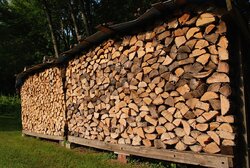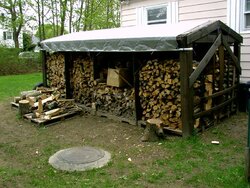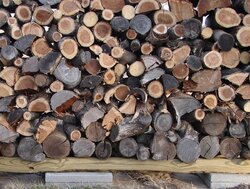Also what about splitting ? I found a website that says splitting doesn't really accelerate the seasoning process. Huh ?
Is there anybody out there that believes using a tarp while seasoning wood is a good thing ?
- Thread starter dave7965
- Start date
-
Active since 1995, Hearth.com is THE place on the internet for free information and advice about wood stoves, pellet stoves and other energy saving equipment.
We strive to provide opinions, articles, discussions and history related to Hearth Products and in a more general sense, energy issues.
We promote the EFFICIENT, RESPONSIBLE, CLEAN and SAFE use of all fuels, whether renewable or fossil.
You are using an out of date browser. It may not display this or other websites correctly.
You should upgrade or use an alternative browser.
You should upgrade or use an alternative browser.
- Status
- Not open for further replies.
I
ISeeDeadBTUs
Guest
using a tarp on the top is better than letting the wood collect rain all summer. But a tarp in probably the next worst thing to nothing.
bogydave
Minister of Fire
Depends on the weather in your area. If in Seattle, a tarp is better than nothing I'd think.
What do you use?
What do you use?
I left my stacks open last summer and top covered in the fall. With the amount of rain we had last summer I wish I would've top covered them the whole year. From this year moving forward it won't be an issue, I'll probably leave my stacks uncovered until the season I need to burn them. I should have wood for 10-11, 11-12 and 12-13 by the time spring rolls around.
WOODBUTCHER
Minister of Fire
I cut/split/stack ....cover just the top and forget it.
Lets put it this way, I've bucked and split 2 yr old trunks of White Oak/Red Oak before and it's usually piss wet (almost like the day it was felled)
So yes, splitting does accelerate the seasoning process.
WoodButcher
Lets put it this way, I've bucked and split 2 yr old trunks of White Oak/Red Oak before and it's usually piss wet (almost like the day it was felled)
So yes, splitting does accelerate the seasoning process.
WoodButcher
Attachments
bigtall
Member
I thought people used tarps because they look so darn good! I didn't realize they actually served a purpose.
WES999
Minister of Fire
Like many things in life it depends, here is a pic of my tarp, I think it is a good thing, my wood stays nice and dry. I do think that just covering the top directly of the wood stack with a tarp is rather poor. Before I built my wood shed I used a tarp, it would blow off, and allow the wood to get wet. 

Attachments
Last year I left all the wood stacked and uncovered through the summer and I covered it late in the fall. It seemed to work. I believe the sun helps tremendously as well so I probably wouldnt even cover the top....but I would be open to suggestions
westkywood
Feeling the Heat
Covering just the top is like having it under a shed. Not much difference. Rubber roofing is the answer...I keep mine covered all year
Skier76
Minister of Fire
My father inlaw gave me some old rubber roofing to cover the wood with. I use some longer (maybe 3-4' long) pine logs to keep the roofing from draping over the sides. In my mind, that helps with air flow.
I completely covered a 10'x4'x16" stack of trimmed limbs with a tarp late last winter to find out for my self. The tarp was weighted on the ground on all 4 sides for 9 months.
After a wet summer/fall I removed the tarp on a cool late fall day. It was damp under the tarp and a strong smell of mold immediately hit me as I started to roll the tarp off the stack. The top of the stack was covered with hundreds of small, winged bugs The color of the ends looked like they had just been cut with only a shallow crack or two in them. The wood was heavy and made a thud sound when 2 pieces were struck together. I wish I had used my moisture meter but I think the wood would have been too wet to measure. This photo was taken 2 1/2 months after the tarp was removed. Some of the seasoned wood in the stack was left over from last winter or dead cut limbs.
The Wood Dog said:wouldnt that restrict airflow and promote humidity ?
After a wet summer/fall I removed the tarp on a cool late fall day. It was damp under the tarp and a strong smell of mold immediately hit me as I started to roll the tarp off the stack. The top of the stack was covered with hundreds of small, winged bugs The color of the ends looked like they had just been cut with only a shallow crack or two in them. The wood was heavy and made a thud sound when 2 pieces were struck together. I wish I had used my moisture meter but I think the wood would have been too wet to measure. This photo was taken 2 1/2 months after the tarp was removed. Some of the seasoned wood in the stack was left over from last winter or dead cut limbs.
Attachments
Skier76
Minister of Fire
mikes67 said:The rubber roofing idea is good, im gonna try that. I bet that gets super hot in the summer and im sure that helps the drying also
Here's a little irony...the stuff I have is a tan color. :lol: It's very durable though. I'd take it over a tarp any day. I can toss pavers and cinder blocks on it and it doesn't rip or mar.
Wood Duck
Minister of Fire
mikes67 said:The rubber roofing idea is good, im gonna try that. I bet that gets super hot in the summer and im sure that helps the drying also
I am sure the top of the rubber roofing gets hot, but how much of that heat gets into the wood, and would more heat get to the wood if the roofing wasn't there? I don't know. I go without tarps, but I would consider covering the tops with roofing if i had some.
Wood Duck
Minister of Fire
The Wood Dog said:Also what about splitting ? I found a website that says splitting doesn't really accelerate the seasoning process. Huh ?
I split my firewood, even the small stuff. i think it dries better when split, and also burns better. I split stuff as small as 2 inches or so if the piece will stand up long enough for me to take a swing at it. Most of the small stuff is kindling, and split kindling ignites better.
Backwoods Savage
Minister of Fire
Common sense says wood will dry much, much faster after being split because there is more wood exposed to air.
As for tarp covering, tarp is the last resort as there are much better things. However, I have used tarps but don't like them.
When to cover? If you live in a really wet area like Seattle, it is probably best to cover the top as soon as you get the wood stacked. However, for our area we find it best to leave the wood uncovered through the first summer and then cover the top of the stack in late fall or early winter. Then there are others like quads who never covers his wood and he gets along just fine.
As for tarp covering, tarp is the last resort as there are much better things. However, I have used tarps but don't like them.
When to cover? If you live in a really wet area like Seattle, it is probably best to cover the top as soon as you get the wood stacked. However, for our area we find it best to leave the wood uncovered through the first summer and then cover the top of the stack in late fall or early winter. Then there are others like quads who never covers his wood and he gets along just fine.
The Wood Dog said:Also what about splitting ? I found a website that says splitting doesn't really accelerate the seasoning process. Huh ?
Now that's crazy talk.
The key word there is probably "really".
firefighterjake
Minister of Fire
Backwoods Savage said:Common sense says wood will dry much, much faster after being split because there is more wood exposed to air.
As for tarp covering, tarp is the last resort as there are much better things. However, I have used tarps but don't like them.
When to cover? If you live in a really wet area like Seattle, it is probably best to cover the top as soon as you get the wood stacked. However, for our area we find it best to leave the wood uncovered through the first summer and then cover the top of the stack in late fall or early winter. Then there are others like quads who never covers his wood and he gets along just fine.
And once again I find myself agreeing with Dennis . . . in fact it seems we pretty much agree on everything except for his love of vertical splitting and my love of horizontal splitting . . .
Split wood: More surface area exposed = faster seasoning. However, it doesn't take a biologist to tell me the how and why of this . . . all one needs to do is take a round of whatever species they want and leave it for X amount of time and then a) split it and check the moisture with a moisture meter or b) split it down and try to burn it in a woodstove . . . and then compare this same wood's moisture content and burning "ability" against a split from the same tree/species that was split at the same time the other piece was bucked up. If you're comparing apples to apples and oranges to oranges (or in our case apple wood to apple wood or osage orange to osage orange) I think you will find that almost always the split piece will be drier than the wood left in the round.
Tarp: Ah, one of the great debates. Cover vs. no cover. My take on it . . . do what works for you in your area. Me, I don't cover. All my wood for 2010-2011 (or at this point it appears as though it will actually be wood for 2011-2012 based on my consumption this year) is naked . . . in the buff . . . no covers . . . no tarps. Yeah, it may have some snow on it and it may get rained on in the spring and summer . . . but in general this moisture doesn't tend to soak into the wood as if it were a sea sponge. I did cover my wood come Fall (pre-woodshed burning year), but it was more of a convenience thing since I didn't want to knock off snow and ice before burning.
Adios Pantalones
Minister of Fire
There's all these people saying it dries so much faster through the ends because the water moves along the fibers in channels and blahdy blah blah. If it was true that drying through sides was so much slower, then leaving it in the round would dry about as fast and it doesn't.
The theory was great right up to the point where it didn't predict reality.
The theory was great right up to the point where it didn't predict reality.
firefighterjake
Minister of Fire
Adios Pantalones said:There's all these people saying it dries so much faster through the ends because the water moves along the fibers in channels and blahdy blah blah. If it was true that drying through sides was so much slower, then leaving it in the round would dry about as fast and it doesn't.
The theory was great right up to the point where it didn't predict reality.
Ah, but reality is over-rated . . . I prefer to live in my own fantasy dream world with the magical pixies and elves . . .

firefighterjake
Minister of Fire
firefighterjake said:Adios Pantalones said:There's all these people saying it dries so much faster through the ends because the water moves along the fibers in channels and blahdy blah blah. If it was true that drying through sides was so much slower, then leaving it in the round would dry about as fast and it doesn't.
The theory was great right up to the point where it didn't predict reality.
Ah, but reality is over-rated . . . I prefer to live in my own fantasy dream world with the magical pixies and elves . . .
Hog . . . could you please pass me a few more of those little red pills . . . no, not the blue ones . . . I already tried those already.


pyper
New Member
I'm putting as much wood as I can in my shed, but what I've got outside I'm coving with pieces of metal roofing.
Around here it rains so much (roughly an inch a week, spread evenly through the year) that wood sitting out in a pile will definitely rot.
Around here it rains so much (roughly an inch a week, spread evenly through the year) that wood sitting out in a pile will definitely rot.
gpcollen1
Minister of Fire
ISeeDeadBTUs said:using a tarp on the top is better than letting the wood collect rain all summer. But a tarp in probably the next worst thing to nothing.
That depends on your climate and the year you have. Normally in the northeast, you do not want a tarp on top from spring to fall. That rain that hits the wood piles is gone so quickly once the sun and wind come back. I will never cover mine until fall.
Then again, there was this June here where it rained 28 out of 30 days in june. Would have been nice to have it covered then...
Backwoods Savage
Minister of Fire
firefighterjake said:Backwoods Savage said:Common sense says wood will dry much, much faster after being split because there is more wood exposed to air.
As for tarp covering, tarp is the last resort as there are much better things. However, I have used tarps but don't like them.
When to cover? If you live in a really wet area like Seattle, it is probably best to cover the top as soon as you get the wood stacked. However, for our area we find it best to leave the wood uncovered through the first summer and then cover the top of the stack in late fall or early winter. Then there are others like quads who never covers his wood and he gets along just fine.
And once again I find myself agreeing with Dennis . . . in fact it seems we pretty much agree on everything except for his love of vertical splitting and my love of horizontal splitting . . .
Split wood: More surface area exposed = faster seasoning. However, it doesn't take a biologist to tell me the how and why of this . . . all one needs to do is take a round of whatever species they want and leave it for X amount of time and then a) split it and check the moisture with a moisture meter or b) split it down and try to burn it in a woodstove . . . and then compare this same wood's moisture content and burning "ability" against a split from the same tree/species that was split at the same time the other piece was bucked up. If you're comparing apples to apples and oranges to oranges (or in our case apple wood to apple wood or osage orange to osage orange) I think you will find that almost always the split piece will be drier than the wood left in the round.
Tarp: Ah, one of the great debates. Cover vs. no cover. My take on it . . . do what works for you in your area. Me, I don't cover. All my wood for 2010-2011 (or at this point it appears as though it will actually be wood for 2011-2012 based on my consumption this year) is naked . . . in the buff . . . no covers . . . no tarps. Yeah, it may have some snow on it and it may get rained on in the spring and summer . . . but in general this moisture doesn't tend to soak into the wood as if it were a sea sponge. I did cover my wood come Fall (pre-woodshed burning year), but it was more of a convenience thing since I didn't want to knock off snow and ice before burning.
Well Jake, until you came along I never dreamed anyone would split their wood wrong! Vertical is the only way to go when splitting wood. Horizontal is the only way to go for some other things. No pill required either. lol
- Status
- Not open for further replies.
Similar threads
- Replies
- 5
- Views
- 717
- Replies
- 3
- Views
- 1K
- Replies
- 15
- Views
- 1K




